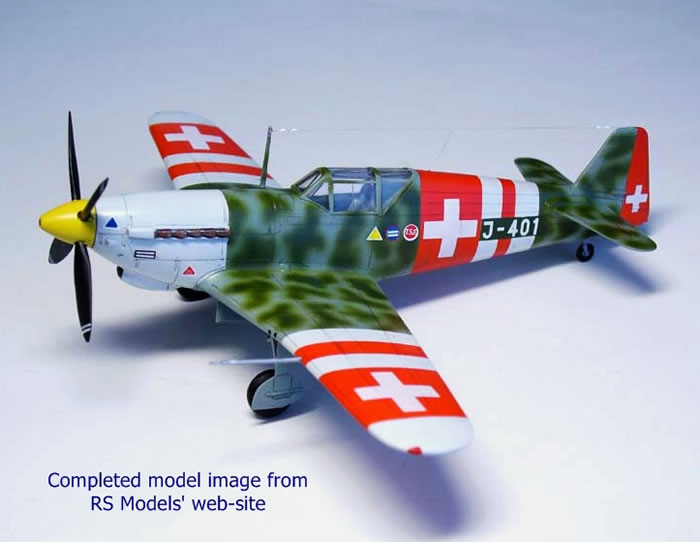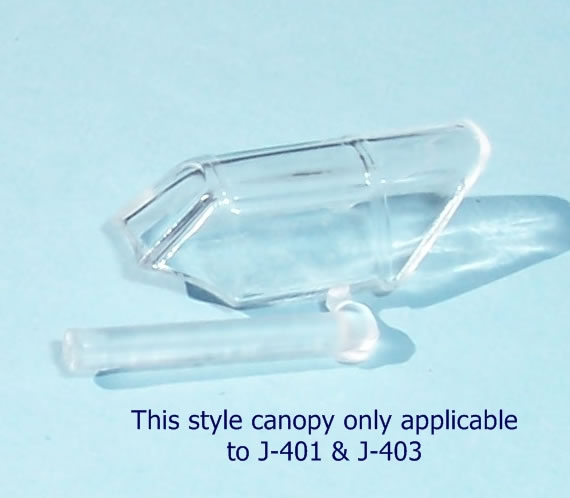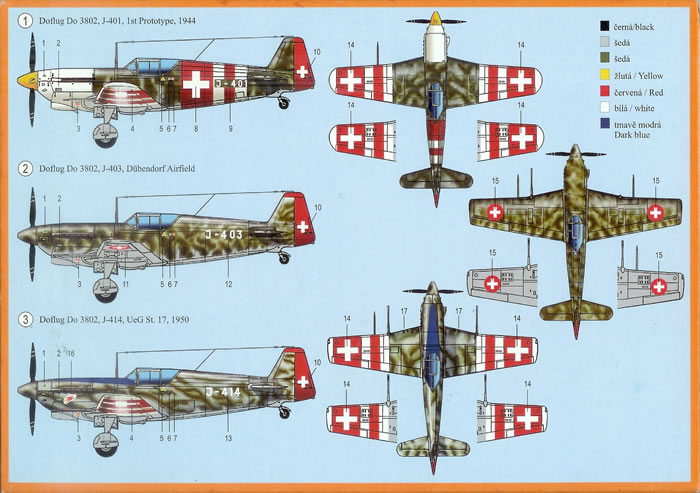|
Doflug 3802
Swiss Fighter from WWII

RS Models, 1/72 scale
S u m m a r y : |
Catalogue Number: |
RS Models Kit No. 92088 - Doflug 3802 “Swiss Fighter from WW2” |
Scale: |
1/72 |
Contents & Media |
43 x grey styrene airframe parts, 1 x clear styrene canopy and decal options for three aircraft. |
Price: |
Available online from Hannants for £13.17 and Modelimex for €15.00 (click here for currency conversion). |
Review Type: |
First Look |
Advantages: |
Fine surface detail, straightforward build, seat belts moulded with the seat. |
Disadvantages: |
The kit only provided parts for the D.4308 prototype and the first of eleven D.4308A’s. A different canopy style is needed for the remaining D.4308A’s, but this is not supplied despite the kit having decals for the last aircraft produced. The colour guide is also vague regarding paint selection. |
Conclusion: |
A simple well executed limited run kit of a rare Swiss fighter, and the last of a famous French lineage. Only two of the twelve airframes produced can be built with the parts supplied. The lack of a bulged canopy in this boxing to enable all of the D.3802A’s to be built is a pity. No doubt RS Models plans a separate D.3802A release with this canopy, and hopefully the bomb racks that were also a feature of the last ten “A’s”. Despite this criticism it’s still Recommended. |
Reviewed by Mark Davies

Valom's 1/48 scale An-2 Colt is available online from Squadron.com
Background
In mid-1940 Switzerland was surrounded by fascist states following the fall of France to Germany in 1940. Its most modern fighters were a few Messerschmitt Bf 109Ds & Es, whilst the bulk of its fighter force consisted of two licence produced versions of the French Morane-Saulnier MS.405 family. These were the D.3800, which was an MS.406, and the improved but generally similar D.3801 based on the MS.412. These were manufactured by Doflug, the Swiss subsidiary of the German Dornier company.
Under the circumstances it seemed unlikely that more Bf 109’s would be available to the Swiss, given that it was Germany who potentially threatened three of the four their borders, and who was also involved in an air war with Great Britain. So Switzerland’s air defence was looking a bit weaker than envisaged by pre-war planners, as the MS.406 had shown itself to be unable to counter the Bf 109 effectively during the Battle for France.
Consequently from mid-1940 the problem of building an improved indigenous fighter was examined in detail. Incredibly this process took 16 months to produce a specification based in large part on plans of the MS.450. The MS 450 was itself a French development of the generally inadequate MS.405 family. The MS.450 prototype flew in 1939 and demonstrated some promising improvements over its predecessors. The Swiss went several steps further however and defined the meed for a multi-purpose fighter primarily for day interception, but also capable of night fighting and ground attack.
The design contract was let in 1942 with the prototype, airframe J-401, first flying on September 29th, 1944. Such a drawn out development might suggest that the Swiss were not feeling too threatened after all! Unlike the D.3801/MS.412 it had an all-metal fuselage and more powerful engine in the form a Saurer YS-2 12 delivering 1,245-hp, with 1,400-hp available for a limited duration. Although the plan shape of the wing was the same as the D.3801 its structure was quite different internally, whilst the older design’s Plymax skin was replaced with an all-aluminium covering. This made for a much stronger wing to cope with the higher wing loading due to the extra weight of the new design. It was also cleaner aerodynamically. The D.3801’s undercarriage was retained, although a second door to fully enclose the wheel was added to reduce drag. An interesting feature of the Escher-Wyss constant-speed propeller adopted was that it had a reverse pitch setting to help reduce landing distance. Fowler flaps and a variable incidence tailplane were other differences from its D.3801 forebear. A second airframe, J-402, was used for static testing.

A production order was made for 100 aircraft in the autumn of 1944, but the first pre-production series did not fly until May 18th, 1946. In the end only eleven pre-production series aircraft would enter service. By this time the design was effectively six to seven years out of date following an unprecedented period of aircraft advancement.
The pre-production series aircraft were designated D.3802A’s. J-403 was partially modified to this new standard with squared off wing tips, two 20-mm cannon in place of the D.3802’s four wing machine guns. Further developments were made with airframe J-404, and it became the first to conform fully to the pre-series specification. It had a bulged canopy for improved rearwards vision, different spar construction, wing racks for either one 200-kg or four 50-kg bombs, and it was plumbed for a centre-line 210-litre drop-tank. Airframes J-406 to J-414 were built to this standard as well.
A more radical modification led to the D.3803 using airframe J-405. It flew in 1947 with a YS-3 engine of 1,500-hp and cutdown rear decking with bubble canopy. However by this time the USA was offering Switzerland 130 war-surplus P-51’s for US$4,000 apiece. It was clear that further development of this Morane-Saulnier lineage was not worth proceeding with, given the P-51’s superior performance and reliability (the D.3802 series had many engine problems early on).
The D.3802A served on until 1956 with Flieger Kompanie 17 (from 1952 known as Fliegerstaffel 17), by which time the Swiss were committed to a jet fighter force using British DH Vampires.
Previous 1/72 D.3802 Kits
I am aware of only one previous D.3802 in 1/72-scale by Dujin. SAMI in December 2004 described it at as not being as refined as many resin kits coming from Eastern Europe. It went on to say that with patience it could be turned into a nice model, although it was unsuitable for beginners. Dujin also offered a D.3803 which, again according to SAMI in January 2005, was of the same standard as their D.3802 kit, and shared all the same parts other than the fuselage and canopy. I’ve see photos of this kit unbuilt, and all but the major parts were cast as a scab requiring lots of cleaning up. It looked quite crude compared to kits from the better resin brands. So a modern injected release of the D.3802 is most welcome.
The kit comes in a typically Czech end-opening box with attractive artwork on the front. However the sub-title: “Swiss Fighter from WW2” is a little misleading given that the type did not enter service until after the war (RS Models do acknowledge this fact in the brief history of the type on their web-site however). The instructions provide a parts map and generally easy to follow diagrammatic assembly format. There is also a brief history of the aircraft with English text.
I have numerous RS kits and this one is quite typical of the brand. All parts are cleanly moulded with fine surface detail and narrow sprue gates. A little flash is visible in places, but will be easily dealt with.
Cockpit detail is reasonable, and consisting of a seat with has moulded belts, instrument panel, floor, control column and two side consoles with additional details moulded in. The clear one-piece canopy is injected, bright and clear, and of acceptable thickness. The canopy is the early flat type as is illustrated as such in the parts map. However in the last stage of the assembly diagrams the bulged type is drawn which only applied to the last ten D.3802A’s (see accompanying image).

Airframe assembly looks to be very straightforward. The instructions do detail a couple of options that builders need to be aware of however:
- The kit seems to me to be optimised to build one aircraft given the parts and decals supplied. This being J-403 that had two 20-mm cannons and early flat style canopy. This opinion is based on the fact that the kit has cannon fairings and ejection chutes moulded in the wings, square wing tips are included, and only the early flat style canopy is supplied. Of course there are also decals for J-403.
- The colourful D.3803 prototype featured on the box-art is airframe J-401. To build this aircraft the cannon fairings and ejection chutes will need to be removed, and four machine gun apertures drilled into the wing leading edge (as the instructions advise the builder to do). I cannot say if the panel lines of the gun access hatches or ejection chutes were different to those moulded, and the instructions do not indicate that a change is required. However, even if the access hatches remained the same, the cartridge and link ejection chutes would have to be different for four machine guns versus two larger calibre cannons. The flat-sided canopy as supplied is correct. The other aspect to cover off is to fit the rounded wing tips, which are supplied as optional parts, as are decals for J-401.
Painting
Painting and decal guides are adequate and printed in colour on the back of the box. Generic colour names are used for colour call-outs, some only in Czech, and the same word is used for two different colours! The colour guide is a bit of a weakness given that many will be unfamiliar with Swiss paint colours, but RS may be forgiven for this as there does not seem to be too much information readily available.
I checked my copy of the IPMS Color Cross-Reference Guide by David H. Klaus regarding Swiss colours. It does not mention the D.3802, but advises that for the D.3801 at least that RLM 70 (black-green), 71 (dark-green), 65 & 78 (both variations of light-blue) could be used. However Air Enthusiast #47 and RS Models both advise that the underlying colour was grey, which is not covered by the IPMS Color Guide just mentioned. Maybe RLM 76 would be a reasonable guess, with I should think RLM 71 for the green blotches applied to the D.3802 & D.3802A.

Just to complicate matters I found black & white shaded colour plans on IPMS Switzerland’s web-site that suggest, for J-406 at least, dark green and two shades of light green including undersurfaces; although I suspect that one of the two light greens is supposed to read light grey.
The kit’s decals look to be well registered with good opacity. Schemes offered are:
- J-401, the prototype, with extensive red and white recognition striping on the wings and fuselage over the randomly sprayed green and grey camouflage, white cowling, yellow spinner and large national insignia.
- J-403, the first D.3802A with randomly sprayed green and grey camouflage finish, and small national insignia.
- J-414, the last D.3803A extensive red and white recognition striping on the wings over the randomly sprayed green and grey camouflage finish, and large wing national insignia. I believe that this aircraft cannot be accurately modelled with the parts supplied (see comments below).
The last decal option provided for in the box, J-414 was the last of ten D.3802A’s produced (J-404 and J-406 to J-414). It is my understanding that these should have the bulged canopy featured in the last page of the instructions but not supplied as a parts option (see accompanying picture). Ideally there would also be the option of wing bomb racks, again not supplied. These last ten machines could also carry a centre-line drop tank, but I have not seen a photo of a D.3802A with one. So without the bulged canopy I believe that J-414, and for that matter any D.3802A other than J-403, cannot be built from this kit.

I suspect RS Models plans to release a D.3802A boxing as their instructions feature the bulged canopy. I hope that they include bomb racks too. I should think that they would also be tempted to issue a kit of the D.3803 if sales of the earlier versions support such a move.
The images accompanying this article of a finished model of the prototype are from RS Models’ web-site.
Caveat
Whilst preparing this article my Internet searches revealed little of use, as information on this aircraft seems scarce. Air Enthusiast #47 was by far the best source I could find, and I hope I have correctly interpreted the information it provides. Good as this publication is, it is still only one source, and I have been unable to crosscheck some of its information. I believe that I am correct regarding the kit’s unsuitability to build any of the last ten D.3802A’s without the bulged canopy and bomb racks, but would encourage builders to do their own research. I would also welcome any additional information readers may have to share by e-mail, thanks.
Thanks to RS Models for these review samples.
Review Text and Images Copyright © 2011 by Mark Davies
Page Created 30 August, 2010
Last updated
30 August, 2011
Back to HyperScale Main Page
Back to Reviews Page

|
